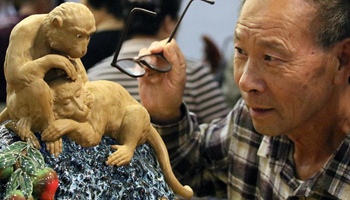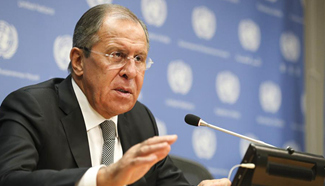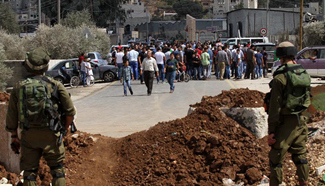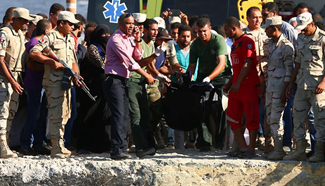CHARLOTTE, the United States, Sept. 23 (Xinhua) -- Forty-three-year old black man Keith Lamont Scott started Tuesday as a father of seven. After being fatally shot by a police who mistook him for someone else, Scott ended the day becoming a new icon for hashtag activism.
While the news of excessive use of force against the black community in the United States had for long been part of the American life, the death of Scott once again highlighted the profound distrust among the black community of the law enforcement officials supposed to protect them.
Three days after the deadly encounter between Scott and the police, the case still remained murky with two contradictory accounts of the shooting by the police and Scott's family leaving the public in confusion and anger.
According to local authorities, police were searching for someone with a warrant when they saw Scott exiting the vehicle in a parking lot with a gun. Scott did not comply when officers ordered him to drop the gun, said Charlotte Police Chief Kerr Putney at a news conference after the incident.
The account of the shooting by the authority was immediately disputed by Scott's family and a witness, who said that Scott was holding a book instead of a gun and was not acting aggressively towards the police.
Speaking here at a press conference on Friday, Putney, also a black, confirmed that at least one body camera and one dashboard camera by police had recorded the incident.
However, he refused to release the footage, arguing that the release of the footage could inflame the situation as the city was already on edge after three consecutive nights of mass protests against police brutality.
However, Scott's family was allowed to see the footage Thursday afternoon and Justin Bamberg, a lawyer for Scott's family said in a statement that after watching the police videos, "It is impossible to discern from the videos what, if anything, Mr. Scott is holding in his hands."
Stressing that Scott was shot as he walked slowly backward with his hands by his side, Bamberg urged the police to release the police videos to the public.
It was not just Bamberg that appeared to be uncertain what the police videos might have pointed out. Earlier on Thursday, Charlotte Police Chief Putney also acknowledged that he could not merely determine from the police videos that Scott was holding a gun.
"The video does not give me absolute, definitive visual evidence that would confirm that a person is pointing a gun," said Putney, adding that he could not see Scott's hands from the video.
For members of the black community, the contradictory accounts of the shooting was not something that struck them as surprising, and with frustration and anger, they took to the street.
"That seems to me the case in most of the shootings that have happened recently as far as there had been conflicting stories with level of frustration was heightened," Lasharee Rogers, a resident of Charlotte, told Xinhua.
"Because people want the answer, and they want the truth. And it's not right to murder someone or shoot someone in cold blood, especially in the hand of someone who are supposed to protect."
The killing of Scott has sparked two nights of violence in Charlotte since Tuesday, during which rioters clashed with riot police, smashed windows, vandalized cars, and assaulted innocent people and journalists.
So far, 17 police officers and nine civilians have been wounded in the unrest, and 44 arrests have been made by the police.
A state of emergency was declared in Charlotte Wednesday night by North Carolina Governor Pat McCrory, who ordered the deployment of the state's National Guard and State Highway Patrol to assist with local law enforcement forces to restore order in the city.
On Thursday night, a curfew order was issued in the city as hundreds of protesters marched peacefully through downtown to protest the fatal police shooting of a black man for the third night.
"I assume that people are supposed to trust the police in the case when they say Scott was posing a threat to the police," said one black journalist present at the protest on Thursday night who only gave his first name as Justin. "But I also assume that the police are supposed to earn the trust of the people by being transparent."
Given that few facts remain known to the public because of the police's refusal to release the footage any time soon, a possible cover-up by the police was on the minds of many locals.
"You want to be able to trust the officer. You want to be able to trust those who are here to help you," said Rogers. "You want to trust the officer, but at the same time because of the track record of the officers, the community is hard to trust them right now."
It was not the first time U.S. police was allegedly involved in covering up shootings of the black.
In another deadly confrontation between police and a black man in Chicago in 2014, it was later known that the local police erased surveillance videos from a nearby Burger King, which may have captured the 17-year-old black teen Laquan McDonald's movement in the critical moment before the shooting, leading to a public outcry about a police cover-up.
Initial police documents showed that several officers who witnessed the shooting appeared to give misleading information to investigators, with one account stating that Jason Van Dyke, the white officer in the case, had been injured by McDonald in the shooting.
Across the country, the majority of the blacks had long been viewing the police force with great suspicion.
According to a poll by the Pew Research Center in August 2014, a total of 62 percent blacks expressed at best "just some" confidence in local police to treat whites and blacks equally, with 46 percent expressing "very little" trust in police.
"We have a situation where many minority communities for so long have felt that law enforcement was coming in essentially to enforce laws against them, not to protect them," said Loretta Lynch, the country's first African- American female attorney general, in July 2015.
Lynch was not the only one to speak out. In May 2015, Vanita Gupta, the Justice Department's Civil Rights Division chief, said that the "lack of trust in the police is real and it is profound."











